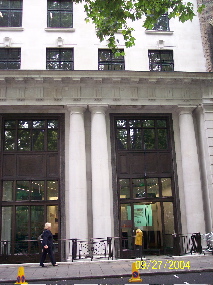Difference between revisions of "Hill and Knowlton"
(→Resources) |
(photo format) |
||
| Line 1: | Line 1: | ||
| − | + | [[Image:HandK.jpg|300px|right|thumb|Hill and Knowlton Offices, Soho Sq, Central London]] | |
| − | + | ||
| − | [[Image:HandK.jpg|300px|right|thumb | ||
| − | |||
=='A company without a moral rudder'== | =='A company without a moral rudder'== | ||
Revision as of 10:38, 23 June 2006
Contents
'A company without a moral rudder'
Hill and Knowlton has been labelled by one ex-employee as "a company without a moral rudder". [1]
The tobacco industry has waged a fifty year campaign to hide the health effects of smoking. In 2005, the US Department of Justice's legal case, asking for a staggering $280 billion in damages, finally reached court. They are arguing that the tobacco industry carried out a fifty year campaign of deception. At its heart was Hill and Knolwton. An Executive Summary of Preliminary Findings notes: [2]
- At the end of 1953, the chief executives of the five major cigarette manufacturers in the United States at the time - Philip Morris, R.J. Reynolds, Brown & Williamson, Lorillard, and American - met at the Plaza Hotel in New York City with representatives of the public relations firm Hill & Knowlton and agreed to jointly conduct a long term public relations campaign to counter the growing evidence linking smoking as a cause of serious diseases. The meeting spawned an association-in-fact enterprise to execute a fraudulent scheme in furtherance of their overriding common objective - to preserve and enhance the tobacco industry's profits by maximizing the numbers of smokers and number of cigarettes smoked and to avoid adverse liability judgements. The fraudulent scheme would continue for the next five decades.
One of the tactics was to create a controversy over health where there was not one. For example one Hill and Knowlton memo from the sixties says: "The most important type of story is that which casts doubt in the cause and effect theory of disease and smoking". Eye-grabbing headlines were needed and "should strongly call out the point - Controversy! Contradiction! Other Factors! Unknowns!" [3]
The PR industry and Hill and Knowlton have tried to keep the controversy open ever since.
Working for oil giants, the nuclear industry and torturers
The firm helped in the aftermath of the Exxon Valdez oil spill in Alaska and the Three Mile Island nuclear accident. [4]
It has worked for Governments with appalling human rights records, including Egypt, Haiti, Indonesia, Morocco, Turkey - and China after the Tiananmen square massacre. [5]. It has also worked for Saudi Aramco, the state run oil company in Saudi Arabia. [6]
The UK office has worked with the Government of Maldives on promoting the country as a tourist destination, whilst Amnesty International has issued a string of warnings and reports about this and the government's repression of the political opposition. [7]
Paving the way to war
Hill and Knowlton played a leading role in the run-up to the first Gulf War. In August 1990, Iraqi troops invaded Kuwait. Fourteen years ago the American public were reluctant to send troops. Selling the war was not going to be easy.
As many as 20 PR firms were used to mobilize US opinion in favour of the war. Hill & Knowlton, then the world's largest PR firm, served as the mastermind for the Kuwaiti campaign. The Kuwaiti government agreed a $12 million contract under which Hill & Knowlton would represent "Citizens for a Free Kuwait," a classic PR front group which hid the role of the Kuwaiti government and its collusion with the Bush administration. [8]
One PR commentator noted about Hill & Knowlton's unprecedented campaign that: "H&K has employed a stunning variety of opinion-forming devices and techniques to help keep US opinion on the side of the Kuwaitis The techniques range from full-scale press conferences showing torture and other abuses by the Iraqis to the distribution of tens of thousands of 'Free Kuwait' T-shirts and bumper stickers at college campuses across the US." [9]
Hill and Knowlton also devised the defining moment that swung American public opinion in favour of war. It arranged for the daughter of the Kuwaiti Ambassador to the US to appear as an ordinary Kuwaiti girl in front of Congress. Her written testimony was passed out in a media kit prepared by Citizens for a Free Kuwait. "While I was there, I saw the Iraqi soldiers come into the hospital with guns, and go into the room where babies were in incubators. They took the babies out of the incubators, took the incubators, and left the babies on the cold floor to die." [10]
It was a testimony that drove the US to war. It was totally false.
People
Notes
- ^ United States District Court for the District of Columbia Civil Action No. 99-CV-02496 (GK) - United States' final proposed findings of fact (pdf), US Department of Justice website, August 15, 2005
- ^ Hill and Knowlton - O'Dwyer's public relations news website, undated, accessed March 2006.
- ^ The President's Office, Maldives, 'Strategic Communications Seminar concludes', June 3, 2004
- ^ Nick Cohen, 'The plot to keep us puffing', New Statesman, 17 January 2000.
- ^ John Stauber and Sheldon Rampton 'How the public relations industry sold the Gulf War to the U.S. - The mother of all clients' - available on PRWatch website, undated, accessed March 2006.
- ^ Andrew Rowell, Green Backlash, Routledge, 1996, p121-123
